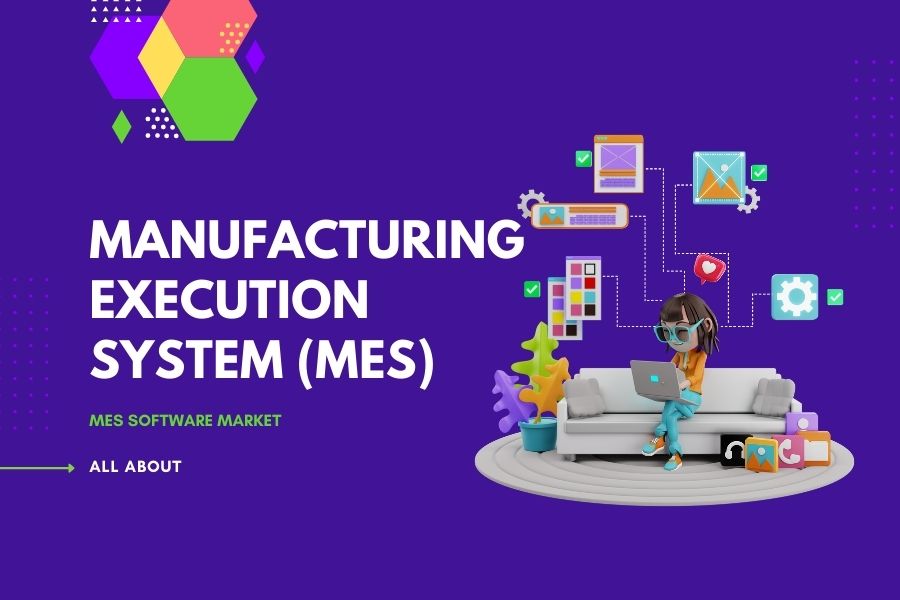Learn What Manufacturing Execution System (MES) Software Market is All About?


Manufacturing Execution System
The buzz surrounding transformational change and emerging technology strategies for the manufacturing industry is growing. Well, we’re here to guide you if you’ve heard of Manufacturing Execution System (MES) Software Market but still haven’t researched what they’re all about. Let’s get started now:
Table of Contents
Manufacturing Execution System (MES) Software Market: Definition
A Manufacturing Execution System (MES) helps companies in ensuring that their manufacturing operations, as well as output. It is a software network that combines, supervises, and controls systems of the factory floor’s machines, work centers, and flow of data. The MES accomplishes this by monitoring and collecting actual information on every piece of equipment involved in the manufacturing process—from order to delivery.
All through the product lifecycle, MES offers companies with data on product traceability and genealogy, effectiveness, suitability, management, work in progress (WIP), and some other plant operations. This data gives policymakers deep insight into how to optimize their operational processes.
An MES can facilitate production processes more efficiently and productive by successfully digitizing data collection and managing the overall system from a unified platform.
The Benefits of Incorporating Manufacturing Execution System
At a substantial stage, MES rewards thrive in three key areas:
- Product traceability (“Track and Trace”)
- Recipe Management
- Machine Process Control
Additionally, Manufacturing Execution System offers several benefits that include:
- Labor Management
- Regulatory Compliance
- Supply Chain Visibility
- Logistics Scheduling & Planning
These qualities can be incredibly useful, particularly if you work in a highly regulated industry where errors can be pricey or disastrous.
But nevertheless, many businesses lack PLC-equipped machinery and equipment or rely on paper to manage operations including such recipes and traces. Makers want to transform their facilities into digital production lines but do not want to invest years of effort and millions of dollars in an intricate MES.
Successful integration is also a challenging task. The complex nature of PLC programming (both in terms of machine-level instruction and the skill involved by the engineering team) has established a very high barrier that many manufacturers have yet to resolve. Time and financial restrictions have made it almost impossible.
What Manufacturing Execution Can Do?
The primary function of a manufacturing execution system is to manage and monitor the flow of goods and services through a production plant. When an order management system, such as a financial accounting package or an MLP system, releases an industrial production works order, a manufacturing execution system would take over.
There is also bidirectional communication with those system applications. The MES must direct the products from one procedure to the next, ensuring that they take the proper path. Furthermore, this must collect all data along the way, erasing errors as early as possible in the process.
Simply put, an MES replaces the paper-based manufacturing traveler with a product from process to process. It is the thing that connects mechanisms. It guarantees that a specific production order follows the correct process, in the correct order, and with the correct parameters. The mes must take command to ensure that everything runs correctly and successfully, and that data is managed to capture instantly.
What Manufacturing Execution System Can’t Do
MES concentrates on the machinery and presumes that all manufacturing execution issues can be fixed using sensing devices and PLC software. In fact, this is a major consideration, but this only accounts for a fraction of the manufacturing operational availability (OA) gap. It fails to include other pivotal abnormality management components such as:
-
Material challenges
One obvious omission in MES is the way of tracking material issues in your manufacturing process. Ordering, wastage of materials, and inventory control are all examples of this.
-
Training problems
Unlike a cloud-based LES scheme, an MES cannot track employees’ performance training and certifications.
-
Quality issues
An MES can assist in managing manufacturing but cannot monitor and control quality checks.
-
Audits
Unlike a full LES method, an MES somehow doesn’t keep track of data and records required for audits.
The Major Components of a Manufacturing Execution System
When introducing a new framework into your process of manufacturing, there are several factors to take into account before introducing something that does not meet your business ’ needs.
Without a doubt, an MES makes a significant contribution to any manufacturing business. However, this sort of system has a long list of features. That’s why you must identify exactly what they can do and how they can benefit your business.
Before introducing new ideas and interrupting your operational processes, it is essential to consider all of the factors given below:
Make a Plan for Your Manufacturing Process
The functions in an MES for this should enable you to do planning process, timetabling, and allocating respective work centers and persons all over a site or multiple locations.
The MES must be aware of the product’s routing as well as the workforce machine specifications. This must easily schedule those into your manufacturing calendar and tell you whether or not you’ll meet the standard delivery window. It should also notify you if there are any issues, then you’ll need to add more resources or rearrange your routine.
Feedback in Real-Time
A Manufacturing Execution System (MES) should provide you with real-time feedback on your manufacturing method. You must be able to see the overall evaluation of effectiveness or the location of specific production orders right away.
This eliminates the need to wander all over your production plant searching for documentation or an order for a particular customer. It also minimizes the time spent gathering effective information from your various work hubs and coordinating it into a report and seeing how well you did the previous week. In this relation, the characteristics of a mess allow you to monitor project progress; create routing for various types of products; as well as acquire information about each of those products as it travels through into the routing.
Quality Features
These are concerned with improving your company’s quality system and making it easier to handle and incorporate with less administration.
Standard operating methods and process documentation that contractors can follow are examples of this. Whether for an assembly or semi-manual procedure or project specifications, showcasing how to define or change a device before swapping to tracking the machine as it runs through a batch. These factors help to standardize processes along with a company or organization, ensuring that when quality improves, everyone moves up to the same level at the same time.
Quality Checks
Another quality feature is the ability to intersperse quality assurance all across your methodology. As a consequence, the problem of massive rework at the end of the route is overlooked. A method that enables you to implement quality and process identity verification early on is an essential component of an MES for maintaining higher quality.
People Management
An MES must include toolkits for tracking and managing people in your process of manufacturing. The skills matrix is one of the qualities you’re searching for here. The capacity to maintain who is trained for what procedure and on what line of products. It makes it simple to handle who has access to what. For instance, if someone is not fully trained, they will be unable to start the equipment, and the system will lock them out. This greatly simplifies adherence to standards and quality audits.
Who Needs MES The Most?
To manage manufacturing full life cycle operation, any company, big and small, will indeed necessitate MES with greater management, regulation, and conciseness. Production companies will be able to produce output with fast data, comprehensive orders, global customer experience, and understanding by incorporating MES into the production process.
Businesses would also require MES to gain genuine insight into manufacturing systems, evaluate product lifecycle time and increase production capability. It also immediately detects errors and slowdowns and determines labor utilization and expense.
Why do You Need to be Careful Before Choosing Manufacturing Execution System (MES)?
Implementing a Manufacturing Execution System requires time, as well as expenditures. It can be significant for a small or medium-sized business with minimal resources. Furthermore, MES has a long life span, likely extended than any production equipment.
Extra costs may arise as a result of data entry, mentoring, maintenance, software upgrades, assistance, and other future cost minefields.
If the classification is matched, a company can reap the rewards of rising manufacturing efficiency and cost-effectiveness. In contrast, selecting the incorrect system can be costly.
It is critical that decision-makers or consumers carefully take into account the cost and functionality. And, most importantly, the particular requirements of their corporation within their sector.
Final Thoughts
Manufacturers want to boost productivity. They can accomplish this goal by continuously understanding and fixing costly issues. Also, handling methodologies and people to foster continual improvement.
Using a Manufacturing Execution System (MES) enables efficient implementation of all manufacturing activities and increases output. Although there are various manufacturing execution devices on the market, selecting one can be difficult.
To make the process easier, start by learning about the product and your firm’s necessitates. Furthermore, cloud-deployed MES is strongly requested to ensure remote connectivity and protection.









